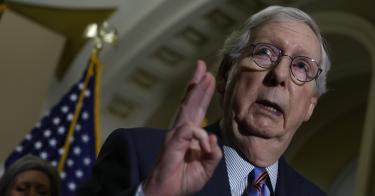The budget and money-spending season officially came to a close this week when the Senate narrowly agreed to a federal budget right on the eve of the start of the new fiscal year on October 1.
But the budget fight isn’t over for the year—far from it. A final budget still needs to be worked out after the midterm elections in November. And Republicans in the Senate still have a card to play that could bring the multi-trillion-dollar spending spree in Washington to a grinding halt in the months ahead. They don’t have to wait until they have a majority in Congress in January. They can make an immediate down payment on their pledge to restore fiscal sanity by unilaterally forcing cuts of more than $100 billion in the weeks ahead. Given the turbulence in the financial markets and global investors terrified of runaway government debt, this would almost certainly calm the stock market.
And there is nothing Joe Biden can do to prevent it.
Yes, we know that $100 billion has become small potatoes out of an obese $6 trillion budget, not to mention the $4.1 trillion of added spending (if the student-loan bailout moves forward) just in Biden’s first 20 months in office.
>>> A Dynamic Score of the Proposals in the Budget Blueprint for Fiscal Year 2023
But it’s a start.
Many voters, however, are skeptical that the GOP will change the Santa Claus culture of spending on Capitol Hill, and for good reason. Last year, 19 Republicans in the Senate irresponsibly gave Biden and Chuck Schumer the margin of victory they needed in the Senate to pass the $1.1 trillion infrastructure/Green New Deal bill last year. Even worse, another 17 voted to hand Biden and Schumer another big government spending victory by voting for this year’s $500 billion welfare bill, which included payouts for the semiconductor industry and other forms of federal aid to dependent corporations.
Now Republicans have a chance to partially atone for their fiscal sins in the lame-duck session in November.
Senate minority leader Mitch McConnell and his colleagues should want to pick a budget showdown fight with Biden, especially because this White House keeps touting its fiscal conservative credentials with a straight face. And it would take only 41 of the 50 Senate Republicans to force Democrats’ hand.
That’s because Biden’s avalanche of spending has pushed outlays far above the allowed budget ceilings, which will trigger the Obama-era “PAYGO law.” These statutory rules require a dollar-for-dollar reduction in mandatory spending for the amount Congress has exceeded the annual spending limits. In recent years Congress has managed to escape these budget handcuffs by reaching bipartisan agreements to waive their rules.
No more. Waiving the budget rules requires 60 votes in the Senate. If Republicans hold firm in sticking to PAYGO, Biden will be required to cut more than $100 billion at the end of this Congress, by choosing one of two ways to comply with the pay-as-you-go rules: an easy way and a blunt way.
The easy option is for Congress to enact a package of targeted spending reductions, at least as much as required by law. Given the largesse and massive waste in the budget, this is an easy task. Just eliminating the waste from the Medicaid, food stamps, and unemployment-insurance programs would pay for the cuts. Likewise, the government would save tens of billions by not expanding the IRS budget.
>>> Two Plus Two Make Five in Biden’s Student Loan Handout
The other option would be to enforce statutory PAYGO spending reductions by allowing across-the-board spending reductions, known as “sequestration,” that cut a small percent from every program.
The Democrats will hate both options, but unless ten Republicans help them out, they are stuck.
Up to this point in his presidency, Joe Biden is by far the most fiscally reckless president in modern times. No other post–World War II president even comes close. It has been his tidal wave of spending and debt that ignited the forest fire of 9 percent inflation, which has reduced the average family’s income after inflation by roughly $3,000 to $4,000 in the last year and a half.
There is almost nothing congressional Republicans could do that would help Fed chairman Jerome Powell extract this cancer cell of inflation from the economy. But if they won’t even take this baby step toward fiscal restraint, then the case to voters for delivering a Republican Congress in November could be greatly diminished. More importantly, the economy will be in even greater danger of a financial crisis.
This piece originally appeared in The National Review




